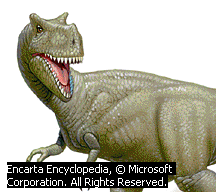HOME
ANIMALS
PREHISTORIC
Tyrannosaurus
 Tyrannosaurus
is the general name of a group of large, two-legged, meat-eating
dinosaurs that lived in the late Cretaceous Period, about 65 million
years ago. The name Tyrannosaurus is derived from the Greek words
tyrannos, “tyrant,” and sauros, “lizard.”
Instantly recognizable by their size, upright posture, jagged teeth,
and small, two-fingered forelimbs, Tyrannosaurus were some of the
largest meat-eating land animals that ever existed. Scientists know
more about Tyrannosaurus than they do about any other predatory
dinosaur. They have found dozens of skeletons of these giant
saurischians (“lizard-hipped” dinosaurs) in Mongolia and
throughout the western United States and Canada.
Tyrannosaurus
is the general name of a group of large, two-legged, meat-eating
dinosaurs that lived in the late Cretaceous Period, about 65 million
years ago. The name Tyrannosaurus is derived from the Greek words
tyrannos, “tyrant,” and sauros, “lizard.”
Instantly recognizable by their size, upright posture, jagged teeth,
and small, two-fingered forelimbs, Tyrannosaurus were some of the
largest meat-eating land animals that ever existed. Scientists know
more about Tyrannosaurus than they do about any other predatory
dinosaur. They have found dozens of skeletons of these giant
saurischians (“lizard-hipped” dinosaurs) in Mongolia and
throughout the western United States and Canada.
Tyrannosaurus are members of the
family Tyrannosauridae, in the suborder  Theropoda.
Although scientists disagree about the number of species in the
genus Tyrannosaurus, some scientists recognize four species, of which
Tyrannosaurus rex is the best known.
Theropoda.
Although scientists disagree about the number of species in the
genus Tyrannosaurus, some scientists recognize four species, of which
Tyrannosaurus rex is the best known.
Tyrannosaurus were among the
largest flesh-eating terrestrial animals, exceeded in size only by
the Giganotosaurus and Carcharodontosaurus. They reached 41 feet in
length and 16 feet in height, and they weighed over 5 metric tons.
The skull of a Tyrannosaurus was large and flexible and contained a
brain comparable in size to those of modern reptiles. Its
bone-crushing bite was probably more powerful than that of any other
flesh-eating dinosaur. The bridge of the nose contained wartlike
knobs and pits. The animals had a broad field of vision but could
focus their eyes directly to the front. A Tyrannosaurus had short
arms with few nerves running through them. This limited nerve
development suggests  that
the arm movements must have been unwieldy and clumsy. The
barrel-shaped chest of these dinosaurs indicates that the lungs were
very large. A latticework of bones protected the stomach and other
internal organs. The legs were long and slender.
that
the arm movements must have been unwieldy and clumsy. The
barrel-shaped chest of these dinosaurs indicates that the lungs were
very large. A latticework of bones protected the stomach and other
internal organs. The legs were long and slender.
Tyrannosaurus probably preferred
open terrain, such as broad game trails and open forests, where it
could move its large body and see unimpeded by brush. Scientists
estimate that Tyrannosaurus could walk rapidly and may have been able
to run at speeds up to 25 miles per hour when chasing prey. They also
could lie in ambush upon a strong pelvic extension, with chin on the
ground, watching for prey with their high-placed eyes.
A uniform body temperature
suggests that Tyrannosaurus had a metabolic rate higher than that of
other reptiles. Therefore, these dinosaurs would have  had
to eat more often than other reptiles. Their stomach could hold more
than half a metric ton of flesh, which it would consume every few
weeks. Scientists have found a 2.1-quart lump of fossilized dung that
contains direct evidence of the prey of Tyrannosaurus: partly
digested bone fragments of young plant-eating dinosaurs. Further
evidence of their diet includes a Triceratops pelvis that exhibits
deep punctures and grooves made by Tyrannosaurus teeth. Like most
active carnivores, Tyrannosaurus probably also fed on the decaying
bodies of dinosaurs killed by starvation and floods. Tooth marks on
some Tyrannosaurus skulls indicate that the animals fought with one
another by biting on the face. In the skull to the right, the eye
sockets are deceptively high. Other orifices are the bone surrounding
the nasal cavities.
had
to eat more often than other reptiles. Their stomach could hold more
than half a metric ton of flesh, which it would consume every few
weeks. Scientists have found a 2.1-quart lump of fossilized dung that
contains direct evidence of the prey of Tyrannosaurus: partly
digested bone fragments of young plant-eating dinosaurs. Further
evidence of their diet includes a Triceratops pelvis that exhibits
deep punctures and grooves made by Tyrannosaurus teeth. Like most
active carnivores, Tyrannosaurus probably also fed on the decaying
bodies of dinosaurs killed by starvation and floods. Tooth marks on
some Tyrannosaurus skulls indicate that the animals fought with one
another by biting on the face. In the skull to the right, the eye
sockets are deceptively high. Other orifices are the bone surrounding
the nasal cavities.
Contributed
By: Dale Alan Russell
Microsoft®
Encarta® Encyclopedia 2002. © 1993-2001 Microsoft
Corporation. All rights reserved.
 Tyrannosaurus
is the general name of a group of large, two-legged, meat-eating
dinosaurs that lived in the late Cretaceous Period, about 65 million
years ago. The name Tyrannosaurus is derived from the Greek words
tyrannos, “tyrant,” and sauros, “lizard.”
Instantly recognizable by their size, upright posture, jagged teeth,
and small, two-fingered forelimbs, Tyrannosaurus were some of the
largest meat-eating land animals that ever existed. Scientists know
more about Tyrannosaurus than they do about any other predatory
dinosaur. They have found dozens of skeletons of these giant
saurischians (“lizard-hipped” dinosaurs) in Mongolia and
throughout the western United States and Canada.
Tyrannosaurus
is the general name of a group of large, two-legged, meat-eating
dinosaurs that lived in the late Cretaceous Period, about 65 million
years ago. The name Tyrannosaurus is derived from the Greek words
tyrannos, “tyrant,” and sauros, “lizard.”
Instantly recognizable by their size, upright posture, jagged teeth,
and small, two-fingered forelimbs, Tyrannosaurus were some of the
largest meat-eating land animals that ever existed. Scientists know
more about Tyrannosaurus than they do about any other predatory
dinosaur. They have found dozens of skeletons of these giant
saurischians (“lizard-hipped” dinosaurs) in Mongolia and
throughout the western United States and Canada. Theropoda.
Although scientists disagree about the number of species in the
genus Tyrannosaurus, some scientists recognize four species, of which
Tyrannosaurus rex is the best known.
Theropoda.
Although scientists disagree about the number of species in the
genus Tyrannosaurus, some scientists recognize four species, of which
Tyrannosaurus rex is the best known. that
the arm movements must have been unwieldy and clumsy. The
barrel-shaped chest of these dinosaurs indicates that the lungs were
very large. A latticework of bones protected the stomach and other
internal organs. The legs were long and slender.
that
the arm movements must have been unwieldy and clumsy. The
barrel-shaped chest of these dinosaurs indicates that the lungs were
very large. A latticework of bones protected the stomach and other
internal organs. The legs were long and slender. had
to eat more often than other reptiles. Their stomach could hold more
than half a metric ton of flesh, which it would consume every few
weeks. Scientists have found a 2.1-quart lump of fossilized dung that
contains direct evidence of the prey of Tyrannosaurus: partly
digested bone fragments of young plant-eating dinosaurs. Further
evidence of their diet includes a Triceratops pelvis that exhibits
deep punctures and grooves made by Tyrannosaurus teeth. Like most
active carnivores, Tyrannosaurus probably also fed on the decaying
bodies of dinosaurs killed by starvation and floods. Tooth marks on
some Tyrannosaurus skulls indicate that the animals fought with one
another by biting on the face. In the skull to the right, the eye
sockets are deceptively high. Other orifices are the bone surrounding
the nasal cavities.
had
to eat more often than other reptiles. Their stomach could hold more
than half a metric ton of flesh, which it would consume every few
weeks. Scientists have found a 2.1-quart lump of fossilized dung that
contains direct evidence of the prey of Tyrannosaurus: partly
digested bone fragments of young plant-eating dinosaurs. Further
evidence of their diet includes a Triceratops pelvis that exhibits
deep punctures and grooves made by Tyrannosaurus teeth. Like most
active carnivores, Tyrannosaurus probably also fed on the decaying
bodies of dinosaurs killed by starvation and floods. Tooth marks on
some Tyrannosaurus skulls indicate that the animals fought with one
another by biting on the face. In the skull to the right, the eye
sockets are deceptively high. Other orifices are the bone surrounding
the nasal cavities.